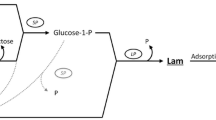Abstract
The recombinant invertase INVB (re-INVB) from Zymomonas mobilis was immobilized on microbeads of Nylon-6, by means of covalent bonding. The enzyme was strongly and successfully bound to the support. The activity of the free and immobilized enzyme was determined, using 10% (w/v) sucrose, at a temperature ranging between 15 and 60 °C and a pH ranging between 3.5 and 7. The optimal pH and temperature for the immobilized enzyme were 5.5 and 25 °C, respectively. Immobilization of re-INVB on Nylon-6 showed no significant change in the optimal pH, but a difference in the optimal temperature was evident, as that for the free enzyme was shown to be 40 °C. The values for kinetic parameters were determined as: 984 and 98 mM for \( K_{m}^{\text{app}} \) of immobilized and free re-INVB, respectively. \( K_{\text{cat}}^{\text{app}} \) values for immobilized and free enzymes were 6.1 × 102 and 1.2 × 104 s−1, respectively, and immobilized re-INVB showed \( V_{\max }^{\text{app}} \) of 158.73 μmol h min−1 mg−1. Immobilization of re-INVB on Nylon-6 enhanced the thermostability of the enzyme by 50% at 30 °C and 70% at 40 °C, when compared to the free enzyme. The immobilization system reported here may have future biotechnological applications, owing to the simplicity of the immobilization technique, the strong binding of re-INVB to the support and the effective thermostability of the enzyme.






Similar content being viewed by others
References
Arroyo M (1998) Immobilized enzymes: theory, methods of study and applications. Ars Pharm 39:23–29
D′Souza S, Melo J (2001) Immobilized of bakers yeast on jute fabric through adhesion using polyethylenimine: application in an annular column reactor for the inversion of sucrose. Process Biochem 36:677–681
Milavanovic A, Bozic N, Vujcic Z (2006) Cell wall invertase immobilization within calcium alginate beads. Food Chem 104:81–86
Vásquez-Bahena JM, Vega-Estrada J, Santiago-Hernández JA, Ortega-López J, Flores-Cotera LB, Montes-Horcasitas MC, Hidalgo-Lara ME (2006) Expression and improved production of the soluble extracellular invertase from Zymomonas mobilis in Escherichia coli. Enzyme Microb Technol 40:61–66
Amaya-Delgado L, Hidalgo-Lara ME, Montes-Horcasitas MC (2005) Hydrolysis of sucrose by invertase immobilized on Nylon-6 microbeads. Food Chem 99:299–304
Yanase H, Iwata M, Kita K, Kato N, Tonomura K (1995) Purification, crystallization and characterization of the extracellular invertase from Zymomonas mobilis. J Ferment Bioeng 79:367–369
Henrissat B (1991) A classification of glycosyl hydrolases based on amino acid sequence similarities. Biochem J 280:309–316
Sambrook J, Fritsch EF, Maniatis T (1989) Molecular cloning: a laboratory manual, 2nd edn. Cold Spring Harbor Laboratory Press, Cold Spring Harbor
Laemmli UK (1970) Cleavage of structural proteins during the assembly of head bateriophage. Nature 227:680–685
Ortega-López J, Morales RLH, Montes-Horcasitas MC, Magaña-Plaza I (1993) Lactose hydrolysis by immobilized β-galactosidase on Nylon-6: a novel spin-basket reactor. Biotechnol Tech 7:775–780
Salleh AB (1982) Protein-alginate gel for enzyme immobilization. Biotechnol Lett 6:387–392
Miller GL (1959) Use of dinitrosalicylic acid reagent for determination of reducing sugar. Anal Chem 31:426–428
Lowry NJ, Rosenbrought F, Randall AL (1951) Protein measurement with the Folin phenol reagent. J Biol Chem 193:265–275
Lineweaver H, Burk D (1934) The determination of enzyme dissociation constants. J Am Chem Soc 56:658–666
Bergamasco R, Bassetti FJ, Moraes F, Zanin GM (2000) Characterization free and immobilized invertase regarding activity and energy of activation. Braz J Chem Eng 17:4–7
Santiago-Hernández JA, Vásquez-Bahena JM, Calixto-Romo MA, Xoconostle-Cázares GB, Ortega-López J, Ruiz-Medrano R, Montes-Horcasitas MC, Hidalgo-Lara ME (2005) Direct immobilization of a recombinant invertase to Avicel by E. coli overexpression of a fusion protein containing the extracellular invertase from Zymomonas mobilis and the carbohydrate-binding domain CBDCex from Cellulomonas fimi. Enzyme Microb Technol 40:172–176
Prodanovic R, Milos B, Zoran M (2003) Immobilization of periodate oxidized invertase by adsorption on sepiolite. J Serb Chem Soc 11:819–824
Tümtürk H, Arslan F, Disli A, Tufan Y (2000) Immobilization of invertase attached to a granular dimer acid-co-alkyl polyamine. Food Chem 69:5–9
Van Cleve JW (1993) Direct benzoylation of d-fructose, In: Whistler RL, Wolfrom ML (eds) (1993) Methods in carbohydrate chemistry, vol II, Academic Press Inc., London, pp 237–238
Torres R, Mateo C, Fuentes M, Palomo JM, Ortiz C, Fernández LR, Guisan J (2002) Reversible immobilization of invertase on sepabeads coated with polyethylenimine: optimization of the biocatalyst’s stability. Biotechnol Prog 18:1221–1226
Ooshima H, Genko Y, Harano Y (1981) Effect of intraparticle diffusion resistance on apparent stability of immobilized enzymes. Biotechnol Bioeng 9:1991–2000
Vallejo-Becerra V, Marín-Zamora ME, Vásquez-Bahena JM, Rojas-Melgarejo F, Hidalgo-Lara ME, García-Ruíz PA (2008) Immobilization of recombinante invertase (re-INVB) from Zymomonas mobilis on d-sorbitol cinnamic ester for production of invert sugar. J Agric Food Chem 56:1392–1397
Shahid H, Farahdiba J, Saleemuddin M (1996) Effects of chemical modification on the stability of invertase before and after immobilization. Enzyme Microb Technol 4:275–280
Mansfeld J, Forster M, Schellengergera A, Dautzenerg (1991) Immbolization of invertase by encapsulation in polyelectrolyte complexes. Enzyme Microb Technol 13:240–244
Monsan P, Combes D (1984) Application of immobilized invertase to continuous hydrolysis of concentrated sucrose solutions. Biotechnol Bioeng 26:347–351
Mazi H, Emrugel E, Rzaev ZMO, Kibarer G (2006) Preparation and properties of invertase on a poly(maleic anhydride-hexen-1) membrane. J Biomat Sci 17:821–835
Kiyokazu I, Tomoo S, Kazuhiro S, Atsuyoshi F (1983) Preparation of immobilized invertase using poly(vinyl alcohol) membrane. Biotechnol Bioeng 25:613–627
Isgrove FH, Williams RJH, Niven GW, Andrews AT (2001) Enzyme immobilization on Nylon-optimization and the steps used to prevent enzyme leakage from the support. Enzyme Microb Technol 28:225–232
Goldstein L, Freeman A, Sokolovsky M (1974) Chemically modified nylons as supports for enzyme immobilization. Polyisonitrile-nylon. Biochem J 143:497–509
Acknowledgments
The research was funded by the Centro de Investigación y de Estudios Avanzados (CINVESTAV-IPN), México. V.V.B gratefully acknowledges a scholarship from the Consejo Nacional de Ciencia y Tecnología (Conacyt), México.
Author information
Authors and Affiliations
Corresponding author
Rights and permissions
About this article
Cite this article
Vallejo-Becerra, V., Vásquez-Bahena, J.M., Santiago-Hernández, J.A. et al. Immobilization of the recombinant invertase INVB from Zymomonas mobilis on Nylon-6. J Ind Microbiol Biotechnol 35, 1289–1295 (2008). https://doi.org/10.1007/s10295-008-0426-6
Received:
Accepted:
Published:
Issue Date:
DOI: https://doi.org/10.1007/s10295-008-0426-6




